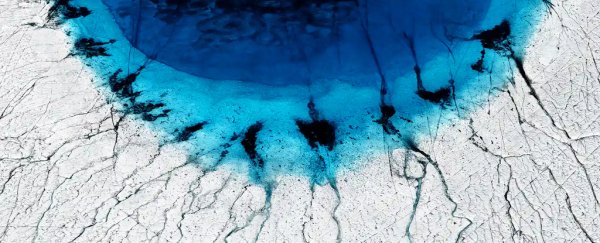It has just rained at the summit of Greenland’s ice sheet for the first time in recorded history, in yet another worrying milestone in our ecological unravelling.
Like much of the Northern Hemisphere, Greenland’s been experiencing a massive heatwave with temperatures at the glacier’s summit rising above freezing for the third time in less than a decade. On 14 August 2021, at a place normally far too frigid for water to fall as a liquid, the National Snow and Ice Data Center’s (NSIDC) Summit Station recorded several hours of rain.
“There is no previous report of rainfall at this location, which reaches 3,216 meters (10,551 feet) in elevation,” NSIDC reported, noting the amount of ice lost in one day was seven times more than the daily average for this time of year.

On August 14, 2021, temperatures rose above freezing on the summit of Greenland, fueling a rain event that dumped 7 billion tons of water—the heaviest since records began in 1950. pic.twitter.com/EyTDhS80f5— National Snow and Ice Data Center (@NSIDC) August 18, 2021
“Greenland, like the rest of the world, is changing,” University of Colorado Boulder glaciologist Ted Scambos told The Washington Post. “We now see three melting events in a decade in Greenland – and before 1990, that happened about once every 150 years. And now rainfall: in an area where rain never fell.”
“Like the heat wave in the [US Pacific] northwest, it’s something that’s hard to imagine without the influence of global climate change.”
Ice sheets form in areas of our planet that do not usually experience melt over the summer. Winter snow piles up over thousands of years, compressing under the weight of new layers.
Previous recent melts here have been caused by warm air temperatures alone, creating growing networks of summer lakes that can accelerate melting and destabilize the ice sheets.
Not only does rain melt snow, contributing to increasing melting events, it also has the added ability to mess with longer term ice sheet dynamics, too.
Rain exposes and freezes into a layer of ice that’s darker and therefore more heat absorbing than the usual white, packed-snow ice of the glacier. Once frozen it will also form a smooth barrier, preventing meltwater from seeping down below the surface. This can then flood the surface of the ice sheet, causing even more melting at higher elevations than runoff usually impacts.
“During melt events, these processes can occur over parts of the ice sheet that do not typically experience melt, making the impact more widespread,” NASA glaciologist Lauren Andrews said. “Positive feedbacks like these are starting to take their toll.”
After heavy rainfall yesterday over the Greenland ice sheet, huge melt today with a surface mass lost (SMB=-7.3GT/day) rate 7 x larger than normal (the highest for Mid-August from 1950). Temperature is still extreme. pic.twitter.com/A0vHINgAAH— Xavier Fettweis (@xavierfettweis) August 15, 2021
The Greenland Ice Sheet holds enough freshwater to make sea levels rise 6 meters (20 feet), and has a large influence on weather and climate. The recent IPCC report warned exceeding 2 degrees Celsius of warming will trigger the collapse of this massive ice sheet. This is one of the major tipping points scientists are very concerned about.
Indigenous communities living in this region are facing challenges from loss of ice and wildlife are feeling the impacts of these changes, too. Beyond the direct impacts to sea level rise, meltwater from Greenland is also predicted to slow the Gulf Stream ocean current, which would alter patterns of tropical monsoons, impacting rainforests.
“We are crossing thresholds not seen in millennia, and frankly this is not going to change until we adjust what we’re doing to the air,” Scambos told CNN.
This will require many of us around the globe working together to hold those most responsible accountable, and helping each other make better collective choices.
Source: Science Alert, 20 August 2021
Leave a Reply
You must be logged in to post a comment.